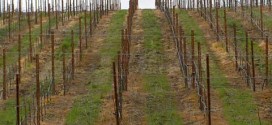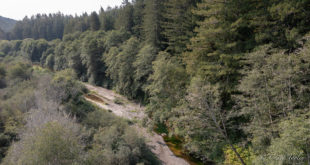| A version of this article was published in the Independent Coast Observer on October 7, 2005. |
By Julie Verran
Courtesy Independent Coast Observer, Gualala, CA
SANTA ROSA – Sonoma County Supervisors on Tuesday continued their struggle to regulate loss of forests to vineyards. The regulatory path the Supervisors must tread is narrow and winding, with court cases on every side.
The forests proposed for vineyards are in Annapolis and Cazadero, just over the first ridge from the coast.
Supervisors reviewed planning staff’s ideas for a proposed ordinance and focused them, asking for a draft they can bring to the public for comment in a month or two. They leaned toward a use permit for conversions.
Supervisor Mike Reilly, whose district is primarily affected, said that the eventual ordinance would provide more forest protection than any county in the state now has.
Chair Tim Smith allowed only brief public comments after board discussion, because there was extensive public comment at a Board of Supervisors hearing on timberland conversions held Aug. 23.
Planner Greg Carr said that after hearing those comments, the Supervisors asked for language allowing flexibility in dealing with individual conversion applications and criteria for defining public benefits that could justify forest loss. They also wanted exemptions for conversion applications already filed and “in the pipeline.”
Carr said there was a mistake in the staff report. It said regulating land use was preferable to regulating timberland conversions. It should have recommended regulating conversions. Smith said he was glad to hear that and had lost sleep over the land use approach.
The California Department of Forestry regulates timberland conversions with a two-step process. Several years ago CDF asked Sonoma County to adopt regulations itself. A court decision since then struck down San Mateo County’s logging regulations, leaving Sonoma County out on a limb.
CDF looked up pending vineyard conversions and found two, Passalacqua, which may be withdrawn, and Codorniu, which sent a letter asking for pipeline help since they are working on an Environmental Impact Report.
The Supervisors decided to set the day’s date, Oct. 4, 2005, as the cutoff point for applications that will go forward without being subject to any new ordinance. Now they can debate and finalize an ordinance without mounting pipeline pressure.
There was much talk of pegging the ordinance to forest site classes 1 through 5, with 1 being the best for timber. There is an idea that forest loss from conversions may be mitigated by restoring some other land to forest productivity. Could loss of class 3, 4 or 5 be mitigated by restoring acreage to a higher class? The word “nearby” was floated.
Supervisor Valerie Brown said she understands there is considerable Mendocino County timberland near Sonoma County land that could be converted. The Supervisors agreed quickly that any land used for mitigation would have to be in Sonoma County.
Conversions should have some public purpose, they decided, and asked staff to come up with criteria for what that might be. That done, Smith opened public comment.
Ric Coates of Forest Unlimited said that site class is plastic – bad forest practices can degrade it, and good practice can improve it.
“I do not believe you have the authority to ban conversions,” Coates said, but they do have the authority to regulate them. “Be very careful how you write [the ordinance],” he said, to avoid exposure to litigation.
Petaluma rancher Al Gearhart said they need to learn more from CDF about what site classes are. He supports grazing cattle and goats on timberland to reduce fire hazard.
Ann Hudgins said the Sierra Club still supports planning staff’s Option 3 for the ordinance, which would ban conversions in timber and resource zonings. She said the ordinance needs more scientific review.
All inspections should be certified by a Registered Professional Forester, Hudgins went on, and timberlands conversions should conform to the county’s recently adopted greenhouse emissions policy.
Richard Wallach said that Preservation Ranch, which plans vineyards on about 10 percent of their 19,000-acre property, will send in letters about what they want in the ordinance.
Several speakers were skeptical of the imprecise, outdated nature of site classes and the shell-game appearance of off-site mitigation. One advised them to take a field trip to look at site classes.
Jay Halcomb of Russian River Residents against Unsafe Logging said the county should hire a forester to verify statements.
# # #
 Friends of Gualala River Protecting the Gualala River watershed and the species living within it
Friends of Gualala River Protecting the Gualala River watershed and the species living within it


